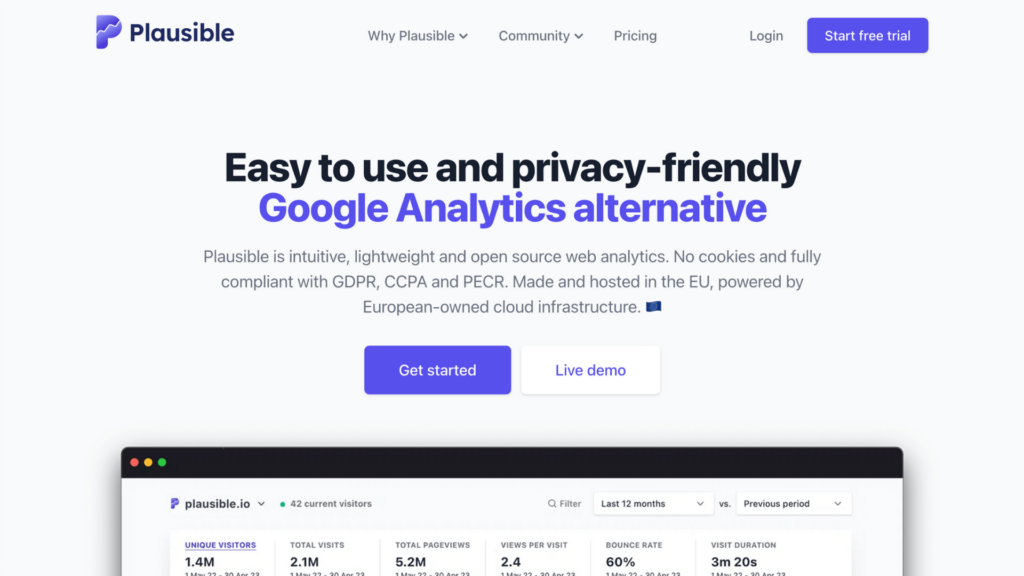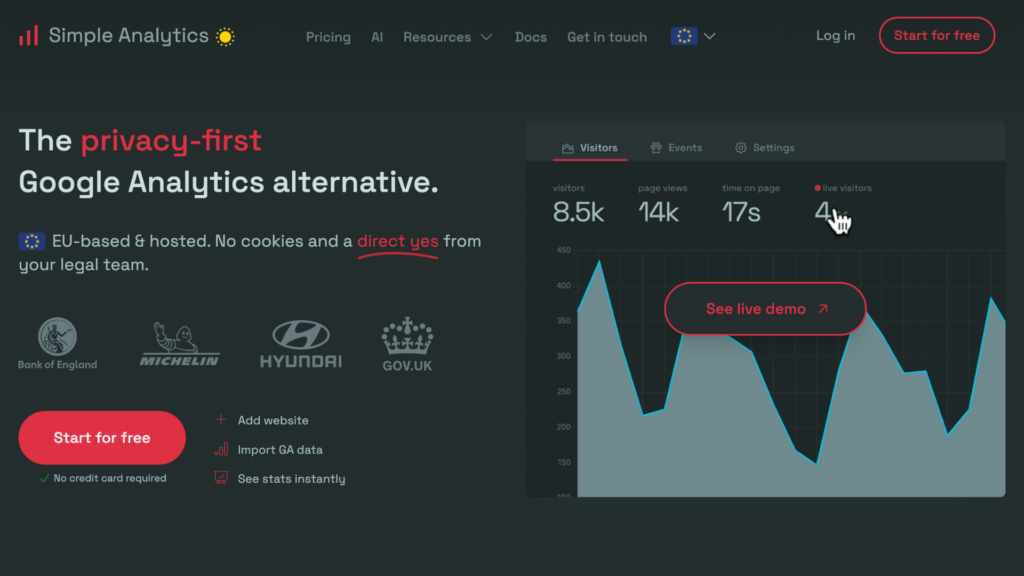Do you really need Google Analytics for your blogs? While it’s a popular go-to tool for many websites, it’s not the only option—nor is it always the best one. The truth is that it can often feel overwhelming, confusing, or overly intrusive for many blog owners.
The good news is that there are many alternative ways to get valuable insights about your blog’s performance. Many of them are simpler, better for your privacy, or perhaps just more suited to specific needs and preferences. Let’s take a look at them below.
Why Look for Google Analytics Alternatives?

Simply put, Google Analytics 4 (GA4), released in 2023 as the latest version of Google Analytics, leaves a lot to be desired. Some polls find that up to a whopping 75% of SEO specialists are not happy with GA4.
Why is this?
Many bloggers find GA4 overly complex. The user interface can be confusing and overwhelming, and some even report inaccurate data processing. Many even prefer Universal Analytics (the previous iteration of Google Analytics).
Additionally, Google Analytics has always been notorious for gathering personal data—both that of website owners and users. It’s why both blog owners and visitors use a VPN on Windows whenever they access their site, especially when they’re travelling and using public Wi-Fi.
While GA4 has seen gradual improvements, many still look to other ways of optimizing their blogs.
The Metrics That Actually Matter

You can still track many key metrics without slogging through Google Analytics. If you want to improve your blog, here are the most important parameters to focus on:
1. Unique Visitors
The number of people visiting your website. A consistent rise in unique visitors usually means your content is gaining more visibility and attracting new readers.
You might be receiving a lot of website traffic, but if they’re only coming from a few people, then it’ll be hard to scale your site (as loyal as those few visitors might be).
2. Page Views per Visit
However, even if you have a lot of unique visitors, that doesn’t mean they’re staying.
People visiting multiple pages when they visit means your content is genuinely engaging and valuable (and that your internal linking strategy is working).
3. Bounce Rate
Bounce rate is the other side of the coin of page views per visit. This metric tells you how many visitors leave after viewing just one page.
High bounce rates often signal that your blog doesn’t leave a good first impression. Perhaps your layout isn’t easy on the eyes or your site takes too long to load. Or simply that your content isn’t meeting visitors’ expectations.
4. Time on Page
Another metric that reveals how useful your content is is how much time visitors spend reading your posts. Low time on page could mean the opposite—or that users are finding the answer quickly and leaving.
5. Traffic Sources
Knowing where your visitors are coming from (search engines, social media, referrals, etc.) allows you to improve how you market your blog. Depending on your strategy, you might want to double down on your largest traffic sources or spread out into your weaker ones.
6. Conversions
At the end of the day, conversions are the end goal:
- Product sales;
- Newsletter signups;
- Course enrollments;
- Form completions.
Whatever it may be, many simpler tools than GA4 can track these various forms of conversion.
Lightweight Tools to Replace Google Analytics

To track the above metrics, here are some of the most popular tools—all without the bloat, complexity, or privacy issues of Google Analytics.
These are likely better than Google Analytics for people who:
- Value simplicity;
- Like clean dashboards;
- Want essential data at a glance.
These are usually small-time bloggers or business owners who are not particularly tech-savvy.
Plausible Analytics

Plausible is a privacy-focused tool where all data is gathered anonymously, and no cookies are used. It’s lightweight, helping you track the essentials—page views, top-performing content, referrals, and goals—and nothing more.
Learn more about Plausible Analytics >>
Fathom Analytics

Fathom Analytics prides itself on being GDPR-compliant straight out of the box, taking both your and your visitors’ privacy very seriously. No cookies are used, and it also has an intuitive, easy-to-learn interface.
Fathom Analytics
-
Starts at $15/month
Use our link for a $10 invoice credit
Learn more about Fathom Analytics >>
Simple Analytics

True to its name, Simple Analytics keeps things simple and minimalist. It only shows the essentials (visitors, referrers, top pages, etc.) without tracking.
Simple Analytics
-
Free version; paid version starts at $15/month
Learn more about Simple Analytics >>
SiteGuru

If you already have Google Analytics linked to your blog but want an easy interface for your data, SiteGuru is a great option. It takes your GA-4 data and drills it down to an actionable to-do list (broken links, posts with declining performance, and low-hanging fruit posts that you can update to rank) .
Site Guru
-
Lifetime deal starting at $79 on AppSumo -
6-week free trial direct through SiteGuru
Grab the Lifetime Deal on AppSumo >>
Other Methods to Track Blog Success

Aside from the usual metrics measured by these analytic tools, there are other ways you can gauge your blog’s performance.
Email Metrics
If you’re sending out newsletters (which you likely should), use your newsletter platform (like MailerLite, ConvertKit, or Substack) to track things like:
- Open rates
- Click-through rates
- Subscription growth
It’s a good sign that people find your brand worth following based on your blogs.
Social Media Engagement
It’s also a good idea to have social media for your brand in addition to blog content.
The built-in analytics tools of these various social media platforms (Facebook, Instagram, Pinterest, etc.) allow you to measure how many people click through to your blog.
The more views, likes, shares, and comments you have, the higher the audience interest generally is.
Google Search Console
Google Search Console is different from Google Analytics. It can tell you:
- What search queries bring people to your site
- How often your pages appear in search results
- Your average click-through rate.
It’s invaluable for SEO tracking, and very lightweight, and is far easier to learn than Google Analytics.
Content Performance Over Time
Use something like a Notion database—or even a good old spreadsheet if you want to do things manually—to track how your blog posts perform. Take note of their traffic, time on page, and conversions, and how they evolve over time.
Analyze any patterns that show up (or lack thereof) and go from there.
Scenario Example: A Yoga Studio in Texas

Imagine you’re running a yoga studio in Austin. Your blog shares yoga information, wellness tips, and updates about community events—all while linking to your classes and trainers.
You don’t want to deal with Google Analytics, so you use one of the tools or methods listed above. You discover that:
- Your blog post titled “Beginner Yoga Poses for Back Pain” is getting the most traffic—mostly from Facebook shares.
- People spend an average of 3 minutes reading that post.
- Many visitors from that post also click your “Book a Class” button.
What insights can you derive from these? And how can you act on them?
- You’re getting the most traffic from beginner yoga practitioners—perhaps you should start marketing to them more?
- Facebook is the social media platform where you’re getting the visibility—maybe you should create more Facebook content? An idea: turn condensed versions of your blogs into Facebook posts.
- Many people already click on the “Book a Class” button on your blog—what if you include a sign-up link on your Facebook posts too?
With these insights, you have a far better idea of what direction to take your blog—and business as a whole—into.
How to Improve Your Blog Without Analytics

Numbers are only part of the story. And they’re only useful if they lead to better decisions. Here’s how to continuously improve your blog, with or without analytics.
1. Deliver Consistent Value
Don’t chase numbers artificially. Simply focus on making sure your blogs are genuinely valuable to your audience. Quality over quantity, always.
2. Improve UX (User Experience)
Sometimes, it may not be the quality of your written blogs. Many people are turned off by the following, even before they can read your blogs:
- Slow load times
- Messy layouts
- Bad font choices
- Confusing navigation
Optimizing these things is just as important as improving your blogs.
3. Ask for Feedback
Often, the best data comes directly from your readers. Ask them directly! Use polls, email surveys, or comment sections to ask what they want to see more of.
Do You Need Google Analytics?
Measuring your blog’s performance—and improving it—without Google Analytics isn’t just possible. It can even be better.
As long as you focus on the right metrics, respect your readers’ time with good content (and their privacy), and choose tools that are the best for your circumstances and preferences, you can grow your blog just as well.



